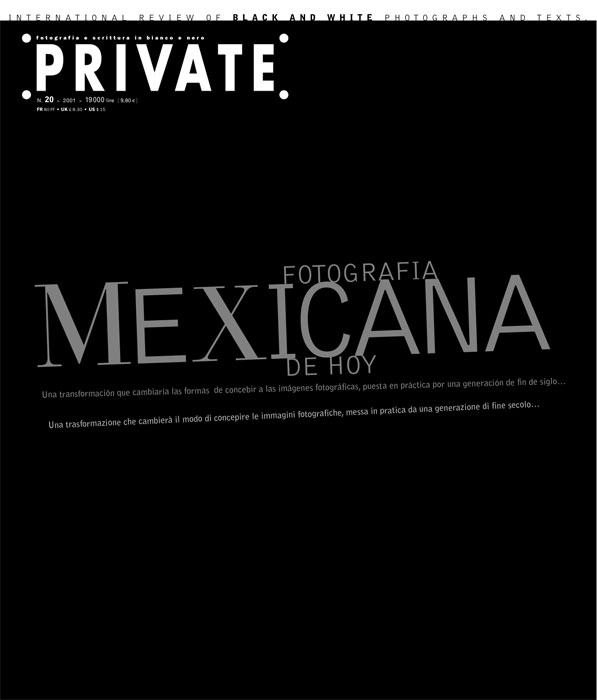
Buy/Gift PRIVATE 20
[A] rich and profound change of Mexican photography occurred in the 90s.
This transformation, initiated by a young generation of photographers of the end of the century, changed the manner to consider photographic images. With these new forms of representation a certain “nationalist” vision, very much spread outside Mexico, praising indigenous communities and their life-styles, was put aside.
A group of young photographers looked in another direction, but the Mexican “indegenous” matter remained the best exported theme. Main art consumption centers considered that it was the theme of Mexican photography. A photography playing with the fantastic and the feeling of the marvellous (indegenous’ faces, rural zoology, local costumes, nature, partial nakedness of “indios”) appealing to a foreign public. That type of photography was successful but was just an aspect of the photographic work. Today, the photographers have come back to the the indegenous topic with the EZLN (Zapatist national liberation army) beeing in the forests of the Mexican south-east (effervescence of the forests, the magic of indegenous masks). With that sort of photography the Chapias state has regained popularity with Mexican and foreign photographers.
There is and there has always been another way to make photography. At the end of the 80s, there was a new impulse for experimental photography which greatly developped in the last decade of the century. It was influenced by different circumstances. Innovative tendencies (especially digital ones) allowing photographers to explore new languages as well as new devices, extended the frontiers of photography, traditionally conceived as a bidimensional image, but also engendered new forms of representation (setting up, video, performance, stage setting, multimedia). In a country like Mexico, social achievements with highs and lows led photographers to put into practice a particular vision which was intimate and through which the world was revealed. There was something of an introspection where personal story, phobias and obsessions of each artist took form.
It is not accidental if these same phobias and obsessions became the big experience of that new contemporary photographic trend in Mexico. It was then the beginning for a symbolic exploration exclusively inspired by the intimate universe. Certainly, an excessive use of that new form of expression was done; too many self-portraits and only the most daring photographer attained a purified self-promotion (without necessarily implying a representation of actions and the perceptions of these actions): a new manner to confer intentions to images.
In the same time, the documentary photography in Mexico was not neglected but the new generation did it in a different way. On the one hand, the appearance of photography, supported by a system of scenography and the use of new technologies replaced the traditional genre, the rural concept. On the other hand, new documentary photographers started concentrating on the theme of urban reality sectionned in districts and specific groups, telling stories sometimes allowing their own presence on the picture. Thus they changed the sketchy tradition, which was restraining the decrepit documentary picture, into a non-intervention of the photographer; the photographer was becoming invisible and a simple viewer of the events. The new photographers who were still practicing this type of photography evicted commonplace concepts in order to fit themselves in their pictures and more precisely to attract attention on their presence. An interaction with their characters and their spaces became obvious for some of them. For others, the documentary photography was no more offering the same possibilities in comparaison to the multimedia. That is why, in the 90s a clear division was born between the “documentary photographers” and “the building photographers” (those who create situations to make their pictures and those who use the digital technique).
Different photographic events (competitions, bienniales) were organised around these two trends. The culture of photographic images enriched with these different approaches, as well as with the new means to appreciate and put this culture into practice. What is shown here is a very small part of today’s Mexican photography.









